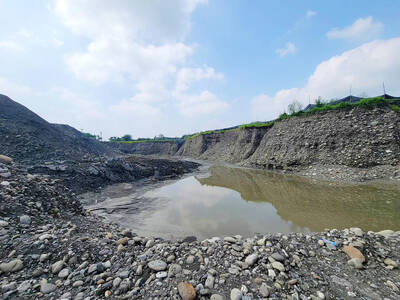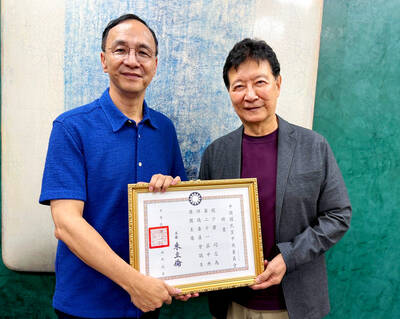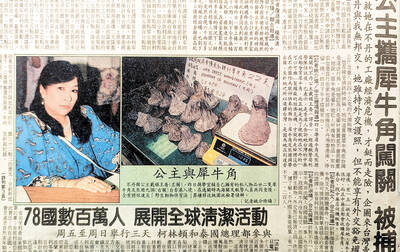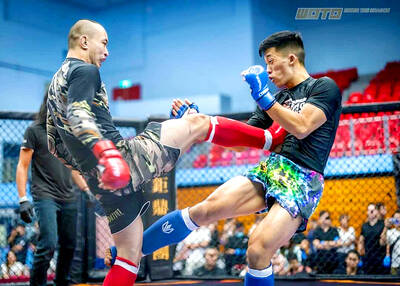Chinese Nationalist Party (KMT) Chairman Eric Chu (朱立倫) hatched a bold plan to charge forward and seize the initiative when he held a protest in front of the Taipei City Prosecutors’ Office. Though risky, because illegal, its success would help tackle at least six problems facing both himself and the KMT.
What he did not see coming was Taipei Mayor Chiang Wan-an (將萬安) tripping him up out of the gate.
In spite of Chu being the most consequential and successful KMT chairman since the early 2010s — arguably saving the party from financial ruin and restoring its electoral viability — he is facing a difficult period in the run up to September’s KMT chair election, which he probably wants to win.

Photo: Tu Chien-jung, Taipei Times
But voices in the party are once again rising against him. Though his reforms since 2021 when he became chairman were necessary for the survival of the party, he made enemies along the way.
With the KMT chair race looming, Chu is facing a series of challenges from party heavyweights, including the term-limited New Taipei City Mayor Hou You-yi (侯友宜), Legislative Speaker Han Kuo-yu (韓國瑜) and, most seriously, Taichung Mayor and favorite to be the 2028 KMT presidential candidate, Lu Shiow-yen (盧秀燕).
Chu has recently been overshadowed by the ambitious powerbroker Fu Kun-chi (傅崐萁), the KMT’s legislative caucus convener.
RECALL CAMPAIGNS
The recall campaigns against KMT lawmakers have considerable momentum, while the KMT-backed recall campaigns against Democratic Progressive Party (DPP) lawmakers have been lackluster. Currently, the DPP only has 15 in the second stage compared to the KMT’s 35 lawmakers — an imbalance blamed on Chu.
Worse for the KMT, several of their party-backed recall campaigns have encountered legal issues in New Taipei City, Taipei, Keeling and Kaohsiung over allegations of forging signatures.
Then last week, Sung Chien-liang (宋建樑), the leader of a KMT-backed recall campaign, wore a Nazi armband and carried a copy of Adolf Hitler’s Mein Kampf into the New Taipei City District Prosecutors Office after being summoned for questioning. While there, Sung performed a Nazi salute. The KMT was slammed for not swiftly condemning this, though eventually they did — yet they still defended him “satirizing” the DPP’s “dictatorship.”
With the legislature not in session and Fu getting less attention, Chu’s protest would be an opportunity to bring the spotlight back on himself, while distracting from the recall campaign and Nazi imbroglio and perhaps even appeal to some Taiwan People’s Party (TPP) supporters. Few political plans have been so ambitious in addressing so many issues at once, and from a political perspective, his plan was a good one politically, barring any surprises.
HOW TO BUILD EXCITEMENT
It is within the above context that Chu called for a protest outside of Taipei City Prosecutors’ Office. He had no time to apply for a permit, and has subsequently been summoned by police for leading an illegal assembly.
That was likely part of Chu’s plan — to underscore his resolve and perhaps become something of a martyr to the party faithful if prosecutors press charges. It also echoes the actions of the TPP that drew thousands of mostly younger supporters to protest the detainment of their founder Ko Wen-je (柯文哲), a demographic that the KMT and Chu deeply covet.
To boost the interest and excitement, Chu has been rolling out some new language not previously used at the top levels in the KMT. He called on the public to not only resist the “red commies” (the Chinese Communist Party) but also the “green commies” (the DPP) that are out to “destroy democracy.”
Some hits included “green terror,” DPP “dictatorship” and “autocratic regime,” but there was also some newer slogans such as “fascist dictatorship,” possibly hoping to distract from the Nazi incident.
Chu decried the “weaponization” of the judiciary, but added some new material by describing them as “hired thugs” out to “chase down and kill” “dissidents,” by which he is referring to members of the KMT and TPP who are being “unjustly” targeted.
To build on the excitement and momentum he hoped to generate, he announced an “arise to battle dictatorship” rally on April 26 on Taipei’s Ketagalan Boulevard.
RALLYING THE BASE
If you find yourself rolling your eyes at the language used, you are not deep blue, and those are exactly the people the KMT and Chu need right now. Chu has made many enemies while reforming the party, including the Huang Fuhsing veteran’s group, which functioned semi-independently within the party as a major power broker, but Chu reduced it to a series of ceremonial committees.
Many local politicians shut out by Chu’s refusal to hold primaries still angers many, while the national association of city and county council speakers and deputy speakers is no fan of Chu’s.
With some key institutional elements within the KMT opposed to him, Chu needs to mobilize the core base rank-and-file to his side in the chair election, and in the shorter term to ensure their turnout in the party’s efforts to recall DPP lawmakers.
The deep blue core shows up to sign recalls and vote in party elections. Chu normally appeals to the center or light blues in general elections, but the current situation strategically requires a very different base-centric strategy.
Many key figures in the party rallied to his call to protest outside the prosecutor’s offices, including Taoyuan Mayor Simon Chang (張善政) and the big prize, Taipei Mayor Chiang Wan-an. He was likely disappointed that New Taipei City’s Hou and Taichung’s Lu did not show, but his turnout was respectable enough.
In many respects Chu’s efforts were successful, with plenty of press coverage, images of him raising his fist defiantly and high profile commentary on his message. Good television and red meat for the base accomplished.
THUNDER THIEF
Chiang then stole much of his thunder by calling for the legislature to pass a vote of no confidence in the cabinet, which would require them to resign within 10 days. They can request the president to dissolve the legislature, which forces new elections.
This drew considerable attention, with speculation largely assuming this was Chiang throwing down a challenge to Chu on his big day as a prelude to entering the party chair race. His proposal has attracted some big backers in the KMT, but a cool response from the TPP.
In an upcoming column we will examine what Chiang was likely up to, the stakes for the various parties and how it is likely to turn out.
Donovan’s Deep Dives is a regular column by Courtney Donovan Smith (石東文) who writes in-depth analysis on everything about Taiwan’s political scene and geopolitics. Donovan is also the central Taiwan correspondent at ICRT FM100 Radio News, co-publisher of Compass Magazine, co-founder Taiwan Report (report.tw) and former chair of the Taichung American Chamber of Commerce. Follow him on X: @donovan_smith.

Last week the story of the giant illegal crater dug in Kaohsiung’s Meinong District (美濃) emerged into the public consciousness. The site was used for sand and gravel extraction, and then filled with construction waste. Locals referred to it sardonically as the “Meinong Grand Canyon,” according to media reports, because it was 2 hectares in length and 10 meters deep. The land involved included both state-owned and local farm land. Local media said that the site had generated NT$300 million in profits, against fines of a few million and the loss of some excavators. OFFICIAL CORRUPTION? The site had been seized

Next week, candidates will officially register to run for chair of the Chinese Nationalist Party (KMT). By the end of Friday, we will know who has registered for the Oct. 18 election. The number of declared candidates has been fluctuating daily. Some candidates registering may be disqualified, so the final list may be in flux for weeks. The list of likely candidates ranges from deep blue to deeper blue to deepest blue, bordering on red (pro-Chinese Communist Party, CCP). Unless current Chairman Eric Chu (朱立倫) can be convinced to run for re-election, the party looks likely to shift towards more hardline

Sept. 15 to Sept. 21 A Bhutanese princess caught at Taoyuan Airport with 22 rhino horns — worth about NT$31 million today — might have been just another curious front-page story. But the Sept. 17, 1993 incident came at a sensitive moment. Taiwan, dubbed “Die-wan” by the British conservationist group Environmental Investigation Agency (EIA), was under international fire for being a major hub for rhino horn. Just 10 days earlier, US secretary of the interior Bruce Babbitt had recommended sanctions against Taiwan for its “failure to end its participation in rhinoceros horn trade.” Even though Taiwan had restricted imports since 1985 and enacted

Enter the Dragon 13 will bring Taiwan’s first taste of Dirty Boxing Sunday at Taipei Gymnasium, one highlight of a mixed-rules card blending new formats with traditional MMA. The undercard starts at 10:30am, with the main card beginning at 4pm. Tickets are NT$1,200. Dirty Boxing is a US-born ruleset popularized by fighters Mike Perry and Jon Jones as an alternative to boxing. The format has gained traction overseas, with its inaugural championship streamed free to millions on YouTube, Facebook and Instagram. Taiwan’s version allows punches and elbows with clinch striking, but bans kicks, knees and takedowns. The rules are stricter than the